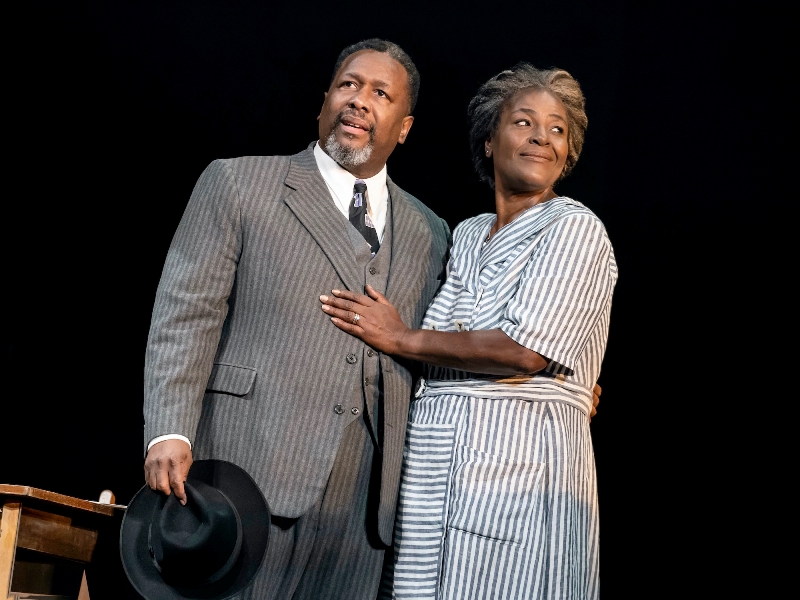Part I:
DEATH OF A SALESMAN
By Arthur Miller
Directed by Miranda Cromwell
Starring Wendell Pierce and Sharon D. Clarke
Hudson Theatre
Official Website
Reviewed by David Spencer
Where the classics are concerned, there’s legitimate reimagining through the prism of inclusion and diversity…and then there’s layer-adding and remonstration—most neutrally described as Theme-splaining.
What is Themesplaining?
Raher than frontload a thesis, let’s take it a step at a time.
We’ll start with what legitimate reimagining is…and then examine the way that gets perverted.
Part I:
Death of a Salesman pretty much does it right. Director Miranda Cromwell has reinvented Arthur Miller’s play about a family crushed by its patriarch’s pursuit of “the American Dream” and the false lures of image, reputation and popularity as a means to prosperity and success.
In major revival, at least in New York City, the family in question, the Lomans, have always been portrayed by white actors. I’ve seen some online speculation that Miller tacitly intended the family to be Jewish, but—speaking as a Jew myself—I’ve never seen any evidence of this, despite Miller’s own Jewish background. I would even posit that, more than any other of the major playwrights of his generation, he was deeply into examining the idea of Americanism: All My Sons as a morality tale about compromised ethics; The Crucible as a reaction to that other Senator McCarthy’s Red Scare and the HUAC, set in the era of the Salem witch trials. To cite but two others.
The first director to tacitly assert (and during Miller’s very active lifetime) that Death of a Salesman was a story bound by no ethnicity was George C. Scott (who also played Willy Loman) at Circle in the Square in 1975. It remains my alltime favorite production, for reasons that would only be discursive here, but what’s relevant to this discussion is how Scott put the message across.
He cast the next-door-neighbor father and son—the ones who just applied themselves to gain their foothold without being seduced by trappings—as African Americans. Chuck Patterson played Bernard: the studious kid who didn’t have Biff’s high school popularity but who has grown into a successful attorney. And Dots Johnson played his father, Charlie…who always has a few bucks for Willy when he’s down-and-out (they both call it a loan, they both know better). Without doing anything to emphasize how much of a social reversal this was, Scott the director let this speak volumes. A black kid, about to argue a case before the Supreme Court; and when his old friend offers Willy a job, “I can’t work for you, Charlie” had another quiet resonance. Quieter than you might think, because the Willy Loman portrayed by Scott was no more capable of recognizing his own racism than his own delusion and would have been hurt and appalled at the suggestion.
But there was the power of the choice.
The choice to let the audience find it of their own accord. To let let it steel upon them. To let the audience realize it. To let that realization trigger self-examination. As it would have to.
47 years later, Miranda Cromwell has somewhat reversed that. She doesn’t leave the “new ethnicity” of the Lomans unexplored. As portrayed at the Hudson Theatre, we’re not merely watching actors of color getting to assay an American classic…we are unambiguously watching a black family. But how do we know this; I mean, aside from the evidence of our eyes, there’s no change in the text. How does Ms. Cromwell achieve it?
By letting them speak the lines as a black family. By letting them inflect in African American patois, including nonverbal vocalizations that occasionally punctuate; by letting gestures of intimacy, humor, anger, camaraderie—most emphatically between Willy’s sons, Biff (Khris Davis) and Happy (McKinley Belcher III), now very streetwise—emphasize the rhythms of a distinct cultural bond that would only seem natural in a black American family. And perhaps most importantly—
By treating it as if it’s unexceptional behavior and speech. As if it was always meant to be that way.
Thus, the pained, lost Willy Loman of Wendell Pierce isn’t just battling the glass ceiling of age in a thankless profession; but by implication, the glass ceiling of being a black man who has lost a power base conferred upon him by a previous while employer (the rein-inheriting son portrayed ruthlessly by Blake DeLong). And in this iteration, Charley (Delaney Williams) and his son Bernard (Stephen Stocking) are white. There may be nothing more to it than contrast—if they had not been cast white, would it be seen as condemnation of white society?—I don’t know—but I do know that when Willy says, “I can’t work for you, Charlie,” the audience has a good deal to think about. And that faith in the audience to think for themselves is what puts this Death of a Salesman over the top.
Does it work 100%. Not…entirely. Your mileage may vary, but I was periodically aware of aspects of Willy’s struggle that, in real life, he and his wife Linda (Sharon D Clarke, excellent in making her perhaps a stronger center of the family than usual) would have to discuss in the context of race and racism; that the text of the play constrains them from doing directly.
But that—ironically—has to do with what the production gets so right: power in the portrayal of what’s right there on the page, through the filter of what’s right there in front of your eyes…but restraint in communicating the purpose being served by the filtering..
Why spell out what’s self-evident?
And that brings us to Part II: A Raisin in the Sun at the Public Theatre.
Link to Part II: A Raisin in the Sun
Link to Part III: 1776
